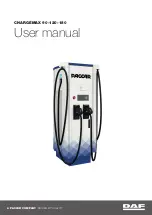
•
10
•
NOTE:
If the engine does turn over but
never starts, there is not a problem with
the starting system; there is a problem
somewhere else with the vehicle. STOP
cranking the engine until the other problem
has been diagnosed and corrected.
ENGINE STARTING NOTES
During the starting sequence, the charger
is set to one of three states:
• Wait for cranking –
The charger waits
until the engine is actually being cranked
before delivering the amps for engine
start. While waiting for cranking, the
digital display shows
rdy
. For 2 hours,
while the charger waits until the engine
is actually being cranked, the battery
is charged in a voltage limited fashion.
After 2 hours, the output of the charger
is turned off but the charger continues
to wait until the engine is actually being
cranked before delivering the amps for
engine start. This state continues until
the charger is disconnected from power
or the user manually changes the charge
rate, using the charge rate button.
• Cranking –
When cranking is detected,
the charger will automatically deliver up
to its maximum output as required by
the starting system for up to 5 seconds
or until the engine cranking stops. The
digital display shows a countdown of the
remaining crank time.
• Cool Down –
After cranking, the charger
enters a mandatory 3 minute (180 second)
cool down state. The digital display
indicates the remaining cool down time in
seconds. It starts at 180 and counts down
to 0. After 3 minutes, the digital display will
change from displaying the countdown to
displaying
rdy
. The CHARGING (yellow/
orange) LED will then be lit.
USING THE BATTERY VOLTAGE
TESTER
1.
With the charger unplugged from the
AC outlet, connect the charger to the
battery following the instructions given
in previous sections.
2.
Plug the charger AC power cord into
the AC outlet.
3.
If necessary, press the BATTERY
TYPE button until the correct type is
indicated.
4.
Read the voltage on the digital display.
Keep in mind that this reading is only a
battery voltage reading; a false surface
charge may mislead you. Compare the
reading to the following chart.
6 V Battery
Voltage
Reading
12 V Battery
Voltage
Reading
Battery
Condition
6.4 or more 12.8 or more
Charged
6.1 to 6.3
12.2 to 12.7
Needs
charging
Less than 6.1 Less than 12.2 Discharged
TESTER AND CHARGER
When first turned on, the unit operates only
as a tester, not as a charger. Selecting a
charge rate activates the battery charger
and deactivates the tester. Pressing the
RATE SELECTION button when the
ENGINE START LED is lit (except during
the 180 second cool down) will shut off the
charger and activate the tester.
POWER-UP IDLE TIME LIMIT
If no button is pressed within 10 minutes
after the battery charger is first powered
up, the charger will automatically switch
from tester to charger if a battery is
connected. In that case, the charger will be
set to charge at the 2A charge rate and Gel
battery type.
TESTING AFTER CHARGING
After the unit has been changed from
tester to charger (by selecting a charge
rate), it remains a charger. To change the
battery charger back to a tester, press the
RATE SELECTION button until all charge
rate LEDs are off.
NOTE:
The battery tester is only designed
to test batteries. Testing a device with
a rapidly changing voltage could yield
unexpected or inaccurate results.
USING THE ALTERNATOR
PERFORMANCE TESTER
1.
With the charger unplugged from the
AC outlet, connect the charger to the
battery, following the instructions given
in previous sections.
2.
Plug the charger AC power cord into
the AC outlet.
Start the vehicle and turn on the vehicle’s
headlights. Read the voltage on the digital
display. If you get a reading between
13.4 volts and 14.6 volts, the alternator
is working properly. If the reading is less
than 13.4 volts or more than 14.6 volts,
have the charging system checked by a
qualified technician.
FAN OPERATION
The charger is designed to control its
cooling fan for efficient operation. It is
normal for the fan to start and stop when
maintaining a fully charged battery. The
fan does not run in Tester Mode. Keep the
area near the charger clear of obstructions,
to allow the fan to operate efficiently.






























